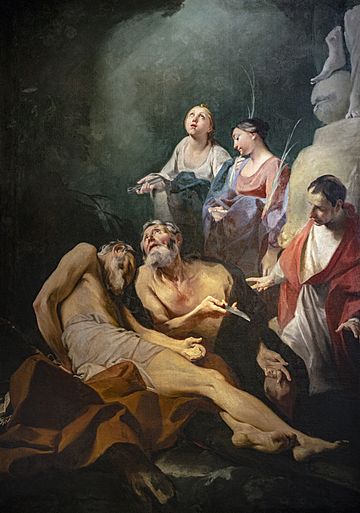Federico Bencovich facts for kids
Federico Bencovich (born 1667 – died 8 July 1753) was a famous painter from Dalmatia. He worked mostly in Italy during the late Baroque period. He is also known by names like Federigo, Federighetto, or Dalmatino. In modern-day Croatia, people call him Federiko Benković.
Contents
Life of Federico Bencovich
Federico Bencovich was born in a place called Venetian Dalmatia. We don't know his exact birthplace, but it might have been in cities like Omiš, Šibenik, or Dubrovnik. It could even have been in Venice itself.
Early Training and Art Style
Bencovich probably started his art training in Venice. Later, he learned from a famous artist named Carlo Cignani in Bologna. In 1706, he helped Cignani paint large pictures on the dome of the Forlì cathedral. These pictures showed the Assumption of the Virgin. His first painting on his own was Juno on the clouds, which he finished in 1705. He also seemed to have worked in the art studio of Giuseppe Maria Crespi.
Important Paintings and Patrons
In 1710, Bencovich painted a large picture for a church in Bologna. It showed St. Andrew on the cross with other saints around him. This painting was later moved to a church in France.
By 1715, he started working for a very important person, the Archbishop-Elector of Mainz Lothar Franz von Schönborn. For him, Bencovich created four large and amazing paintings for a gallery in Schloss Weißenstein. These included Apollo and Marcia, Hagar and Ishmael in the Desert, Iphigenia’s sacrifice, and Abraham’s sacrifice of Isaac.
Later Years and Legacy
Bencovich spent his last years in a town called Gorizia. After he passed away, people slowly forgot about his art. His paintings were sometimes thought to be done by other artists, like Piazzetta.
-
Saint Francis of Paola (an etching made by Giovanni Marco Pitteri based on Bencovich's work)
Notable Artworks
Federico Bencovich created many important artworks throughout his life. Here are a few examples of his paintings and where they can be found:
- In Zagreb, at the Strossmayer Gallery, you can see Sacrifizio d'Isacco, painted around 1720.
- The Giunone (Juno) painting is in Forlì, at Palazzo Orselli Foschi.
- In Berlin, the Staatliche Museen has his Madonna e santi, from 1730 – 1735.
- His painting Deposizione (around 1735) is in the Church of the Castle in Borgo San Giacomo, Verolanuova, Brescia.
- The Church of the Holy Trinity in Crema has his Estasi di S. Francesco da Paola, painted in 1724.
- At Weißenstein Castle in Pommersfelden, you can find Hagar and Ishmael in the desert and The Sacrifice of Iphigenia, both from around 1715.
- The parish church in Senonches, France, holds his Crucifixion of St. Andrew and Saints, from about 1725.
- The Staats-Galerie in Stuttgart has his Adoration of the Magi, from around 1725.
- In Venice, the Church of S. Sebastiano has Il beato Pietro Gambacorta, from about 1726.
- The Gallerie dell'Accademia in Venice displays his Autoritratto (self-portrait), from around 1735.
- The Albertina in Vienna has drawings like Departing for Egypt and Rest while escaping in Egypt, from about 1745.
See also
 In Spanish: Federico Bencovich para niños
In Spanish: Federico Bencovich para niños






